How Long Does Pain Last After Hip Arthroscopy
Hip Arthroscopy
Arthroscopy is the examination of the interior of a joint past using an arthroscope or "telescopic" – a flexible, cobweb-optic tube with a small-scale camera that is connected to a monitor. This allows a surgeon to come across a magnified view of your articulation. Specially designed arthroscopic surgical tools are also used to perform different types of minimally invasive articulation surgery.
Arthroscopy of the hip joint was refined in the tardily 1980s and early 1990s. Since then, the development of advanced arthroscopic surgical equipment has allowed orthopedic surgeons to treat conditions that were previously untreatable or which required more invasive, open procedures.
- What is hip arthroscopy?
- What are the advantages of hip arthroscopy?
- Which hip weather can exist treated arthroscopically?
- Overview of a hip arthroscopy process
- Hip arthroscopy recovery
- Further reading: Articles on hip arthroscopy
What is hip arthroscopy?
Hip arthroscopy, sometimes called a "hip scope," is a minimally invasive procedure in which an orthopedic surgeon uses an arthroscope to examine the inside of the hip joint.
This procedure allows the surgeon to diagnose the cause of hip pain or other problems in your articulation. Some hip conditions may likewise be treated arthroscopically. To perform arthroscopic hip surgery in these cases, the surgeon makes boosted small incisions (usually one or two) to create access points for various arthroscopic needles, scalpels or other special surgical tools.
Hip arthroscopy video
View this pace-past-step blitheness of a hip arthroscopy process.
What are the advantages of hip arthroscopy?
A hip scope has several advantages over traditional open up hip surgery, because it:
- causes very picayune trauma to the joint (which minimizes hip pain and scarring)
- is generally done on an outpatient basis (where patients render home later on the procedure)
- typically has a short recovery menstruum
- may postpone the advocacy of hip arthritis past treating its cause in the early stages
- tin can delay or eliminate the need for a hip replacement by preemptively treating conditions that cause osteoarthritis of the hip
Which hip weather can be treated arthroscopically?
Mutual injuries and conditions that can be fixed with arthroscopic hip surgery are:
- hip impingement (femoroacetabular impingement), which limits range of motion and is a major cause of osteoarthritis
- repair or trimming of a labral tear, where a specialized cartilage called the labrum, which lines the hip socket becomes torn
- removal of:
- loose fragments of cartilage within the joint (which are usually acquired past an injury, such as a torn labrum)
- diseased or inflamed articulation lining
- painful bone spurs
Is hip arthroscopy correct for you?
Because HSS uses high-resolution MRI scanning engineering science, a hip arthroscopy is not always required to make a diagnosis. Our country-of-the-art scans may reveal that your injury or condition can exist treated nonsurgically, such equally with physical therapy. For this reason, at HSS, arthroscopic surgery is frequently performed only when reparative surgery is needed, rather than for exploratory purposes.
To determine whether a hip arthroscopy is correct for your situation, your dr. will outset:
- acquire about your symptoms and medical history
- review your imaging (X-rays, CT scans and/or MRIs)
- deport a physical examination that may include range-of-motion tests
Overview of a hip arthroscopy process
Arthroscopic hip surgery is usually conducted on an outpatient basis, where the patient returns domicile on the same day every bit the surgery. Depending on your doctor'south findings and the type of treatment that will exist performed, arthroscopic hip surgery may accept betwixt xxx minutes and two hours.
Preparation
Prior to the process, you lot will be given anesthesia to prevent the sensation of pain. You lot may undergo full general anesthesia, in which a gas puts you to slumber, or regional anesthesia, in which an injection or small tube (catheter) delivers medication to the spinal column, numbing yous from the waist down. At HSS, more than than 90% of hip arthroscopy procedures are performed under regional anesthesia, rather than general anesthesia. This lowers risks and decreases the time between surgery and a patient'southward discharge from the hospital.
Most frequently, you lot will be positioned with your leg pulled in traction. This creates space in the hip joint and allows instruments to access the joint without injuring surrounding cartilage. Accessing the narrow space in the hip articulation is complicated by the orientation of surrounding nerves and claret vessels. To ensure the arthroscope and instruments are inserted properly, a portable X-ray device called a fluoroscope volition exist positioned for use during the procedure.
Incisions and accessing the joint
Your surgeon will make 2 or 3 small, one-quarter to half inch long incisions called portals along pre-marked sites.
Beginning, a needle will exist inserted into the joint infinite, and when positioning is confirmed with the fluoroscope, the joint is injected with a sterile, water-based solution, creating fluid pressure to help concur open the joint. An incision is fabricated, and a guide wire is passed through the needle, which is withdrawn.
Next, a thin tube, called a cannula, is inserted over the guide wire into the articulation space. The wire is withdrawn, and an arthroscope is inserted through the cannula to visualize the joint. The other one or two portals are accessed similarly, and once consummate, the location of the arthroscope or instruments tin can be inverse to view the joint or repair tissues from a diversity of positions. Fluid may be directed into and out of the joint through attachments on the arthroscope or via other portals to aid viewing within the joint.
Diagnosis and surgical repairs
Typically, your surgeon will examine the condition of the articular cartilage that covers both the caput of the hip ball (the femoral caput, located at the top of your thighbone) and the inside the socket (the acetabulum). This cartilage allows the bone surfaces to slide against each other smoothly. Your surgeon volition besides examine the:
- condition of ligaments attaching the bones to each other
- the business firm ring of cartilage surrounding the hip socket, called the labrum, to look for a hip labral tear
- space inside the articulation to determine whether in that location are loose bodies of cartilage cloth or signs of inflammation or degenerative conditions such as osteoarthritis
Fluoroscopic and arthroscopic images illustrating hip arthroscopy
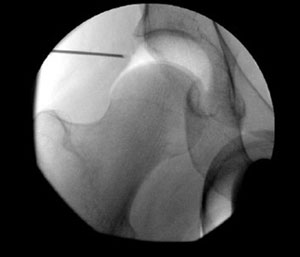
Traction creates space for instrument insertion
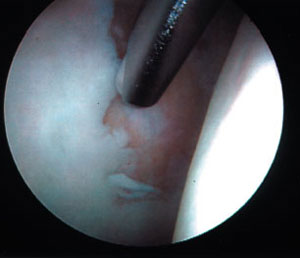
Cleaning away torn cartilage
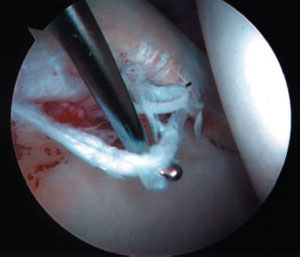
Torn labrum at rim of socket
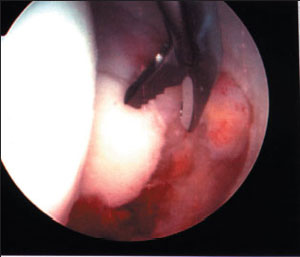
Removal of loose trunk from within the hip
End of the procedure
Once exploration and any treatments are complete, your surgeon will withdraw the arthroscope and whatsoever other instruments. Your incisions may be closed with two to three non-dissolvable sutures and covered with small bandages, or they may exist held closed with wound closure surgical tape strips.
You may be given a prescription for pain and directed to ice the area. Your doc may also advise you on what to clothing later on hip arthroscopy, such every bit a brace and types of vesture to accommodate a brace. Yous may also need to walk on crutches or otherwise limit weightbearing on your leg for a menstruation of fourth dimension.
Hip arthroscopy recovery
How long does pain last after hip arthroscopy?
Symptoms oft amend immediately post-obit the process, just recurrence of some pain can occur as the irritated joint lining heals, and temporary tenderness in the hip and human knee from the traction may occur.
You lot may also feel a sensation of h2o in the hip or hear gurgling noises resulting from the fluid used during surgery, but this volition apace be absorbed by the body. Swelling should subside within about a week and any sutures will typically exist removed in seven to ten days. Your total recovery time may vary, depending on the specific handling performed during your procedure.
Hip arthroscopy patients must unremarkably use crutches for one or ii weeks afterwards surgery and exercise 6 weeks of physical therapy. It may be three to six months before they feel no pain subsequently physical activity.
Not all hospitals reach the same results
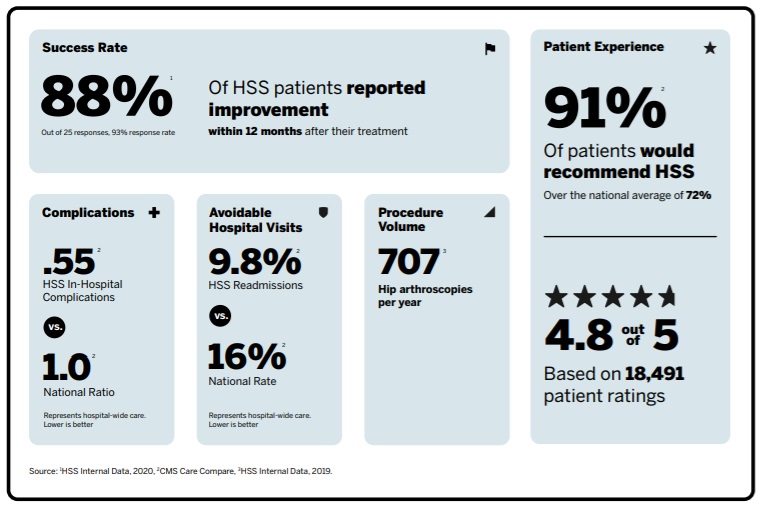
Hip arthroscopy and other minimally invasive surgeries often consequence in less pain, minimal scarring and rapid recovery. But not all hospitals achieve the same results. Some are more reliable than others. With the assist of the HSS Hospital Reliability Scorecard, yous can make sure you lot're request the disquisitional questions to find the hospital that's right for you. Agreement the data points below volition help you make the best decision for your care.
Download your Hospital Reliability Scorecard
In the news
Source: https://www.hss.edu/condition-list_hip-arthroscopy.asp
Posted by: rootrhou1970.blogspot.com

0 Response to "How Long Does Pain Last After Hip Arthroscopy"
Post a Comment